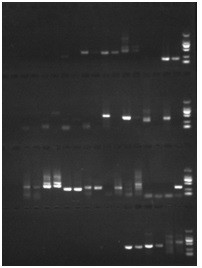A low-salt-tolerant molecular marker c62 of Portunus trituberculatus and its application
A technology of Portunus trituratus and molecular markers, applied in the direction of microbial determination/inspection, biochemical equipment and methods, DNA/RNA fragments, etc., can solve the lack of markers in molecular marker-assisted breeding, juvenile crab feeding rate, metamorphosis rate and Reduce the survival rate, affect the normal molting and growth of adult crabs, etc., to achieve the effect of promoting healthy reproduction, improving feeding rate, and increasing the number of
- Summary
- Abstract
- Description
- Claims
- Application Information
AI Technical Summary
Problems solved by technology
Method used
Image
Examples
Embodiment 1
[0022] 1. Screening of candidate molecular markers related to low-salt tolerance traits
[0023] 1. Sequencing data filtering and comparison
[0024] The DNA extraction was carried out using the kit of Quanshijin Company, and the DNA extraction was carried out by using the principle of specific adsorption of DNA on the silica gel membrane spin column. First, put about 30mg of tissue samples into a 1.5ml sterile enzyme centrifuge tube, add 200μl LysisBuffer 8 (LB8) and 20μl RNaseA (10mg / ml), shake for about 10s, incubate at room temperature for 2min, add 20μl Proteinase K (20mg / ml), fully shake and mix, incubate at 55°C until completely lysed, add 1.5 times the volume of Binding Buffer 8 (BB8), mix well and add to the spin column, in a high-speed low-temperature refrigerated centrifuge (Eppendorf5804R) Centrifuge at 12000rpm for 30s, and discard the waste liquid. Then add 500μl of Clean Buffer 8 (CB8), centrifuge at 12000rpm for 30s, discard the waste solution (repeat once), ...
PUM
 Login to View More
Login to View More Abstract
Description
Claims
Application Information
 Login to View More
Login to View More - Generate Ideas
- Intellectual Property
- Life Sciences
- Materials
- Tech Scout
- Unparalleled Data Quality
- Higher Quality Content
- 60% Fewer Hallucinations
Browse by: Latest US Patents, China's latest patents, Technical Efficacy Thesaurus, Application Domain, Technology Topic, Popular Technical Reports.
© 2025 PatSnap. All rights reserved.Legal|Privacy policy|Modern Slavery Act Transparency Statement|Sitemap|About US| Contact US: help@patsnap.com



